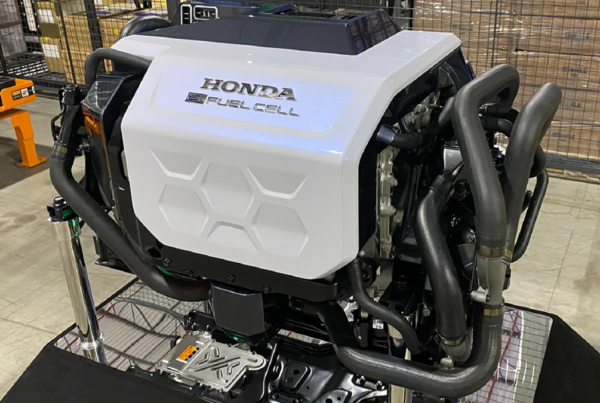
- German start-up opens a new chapter in water electrolysis with eight patent applications
- 25 years of expertise lead to economical PEM electrolysis stacksAdd New
- Prometheus: High performance, low cost – thanks to innovations in design & materials
- Clear goal: Green hydrogen for less than EUR 4/kg
WISMAR, Germany — Climate-neutral energy-generating it, storing it efficiently and making it available again. One of the central issues in the energy transition in order to achieve global climate targets.
Hydrogen has long been regarded as the ideal solution here but has yet to make the final breakthrough, even though the principle of splitting water (electrolysis) to generate energy is nothing new. Various companies around the world are working to increase the cost-effectiveness, possible applications, and efficiency of the technology to such an extent that it can be used as a clean alternative source of energy in the everyday lives of individuals and companies. Especially in the industrial sector, there is a high energy demand, which must be covered in the future in a climate-neutral and cost-effective way.
This is exactly where the German company HOELLER Electrolyzer and its Prometheus series come in: A range of extremely compact electrolysis stacks based on 25 years of expertise in PEM (polymer electrolyte membrane) technology and eight patents pending. The first Prometheus will go into test operation in the third quarter of 2020.
Prometheus makes green hydrogen available on almost every company site
No matter whether you are a wind turbine operator, hydrogen filling station, or industrial enterprise/large-scale operation with fleets of trucks and forklifts or freight trains. In the future, they all will need cost-effective and reliable energy solutions.
This is precisely what Prometheus electrolysis stacks offer. They are the easy-to-integrate, cost-effective, and powerful centerpiece of climate-friendly hydrogen and thus energy production for every plant manufacturer.
The goal of engineer and company founder Stefan Höller: “We want to enable every company to produce green hydrogen independently, economically and decentrally on their company premises. Thanks to Prometheus, the price per kilogram of hydrogen will be below 4 euros.”
For this purpose, HOELLER Electrolyzer offers its Prometheus stacks in three compact sizes and power ratings.
The smallest stack is the size of a water carbonator and has a power rating of 76 kW – the largest 1.4 megawatts
Prometheus S – achieves a power rating of 76 kW, produces 34 kg of hydrogen per day, and with a footprint of 25 x 21 cm. It is about the size of a water carbonator. At 1,500 full load hours per year, it can produce sufficient hydrogen to power seven cars or two forklift trucks. A car can be filled up within three minutes.
Prometheus M – has a power rating of 325 kW, produces 147 kg per day, and with a footprint of 42 x 29 cm and is therefore about the size of a crate of mineral water. At 1,500 full load hours per year, it can produce sufficient hydrogen to power 32 cars, seven forklift trucks or one passenger bus.
Prometheus L – has a power rating of 1.4 megawatts, produces 635 kg of hydrogen per day, with a footprint of 60 x 48 cm and is therefore about the size of four crates of mineral water. At 1,500 full load hours per year, the most powerful PEM stack from HOELLER can produce sufficient hydrogen to refuel 140 cars, 30 forklifts, five buses, two trucks or half a train.

Prometheus stacks take up 25 percent less space
In addition to performance and economy, the low space requirement and reduced overall weight are decisive competitive advantages. The electrolysis stacks from HOELLER save about 25 percent in space and weight, which also makes it possible, for example, to integrate them into the rotor head of a wind turbine.
HOELLER PEM electrolysis stacks: The technology, innovations and patents behind them
But what exactly makes Prometheus stacks more economical and efficient than other electrolysis stacks?
In brief: HOELLER has succeeded in considerably reducing the cost-intensive use of the precious metals platinum and iridium. This is made possible thanks to an in-house innovation. By improving the surface structures, the reaction area is increased – this in turn leads to an increase in the performance of HOELLER stacks.
In addition, the electrolysis cells have a fundamentally innovative design to further increase efficiency. Since fewer precious metals are used, production is also significantly cheaper and possible in large quantities.
Another factor is the achievement of the highest possible output pressure of 50 bar and more to reduce the energy required to compress the hydrogen for storage.
HOELLER is already ahead of some of its competitors in these points but continues to optimize its PEM electrolysis stacks in order to take a leading position in this technology going forward.
About HOELLER
With its innovative PEM technology, HOELLER Electrolyzer GmbH is developing the future source of green hydrogen. The innovative PEM electrolysis stack Prometheus is the result of more than 25 years of expertise and pioneering work by the engineer, managing director and head of development Stefan Höller. In these stacks, water is split up into hydrogen and oxygen by adding electricity. This makes them the core component of future electrolysis or power-to-x systems. With Prometheus, HOELLER is above all aiming to achieve convincing value for money, minimized hydrogen production costs, impressive maximum performance, outstanding service life and high hydrogen output pressure.
Read the most up to date Fuel Cell and Hydrogen Industry news at FuelCellsWorks




